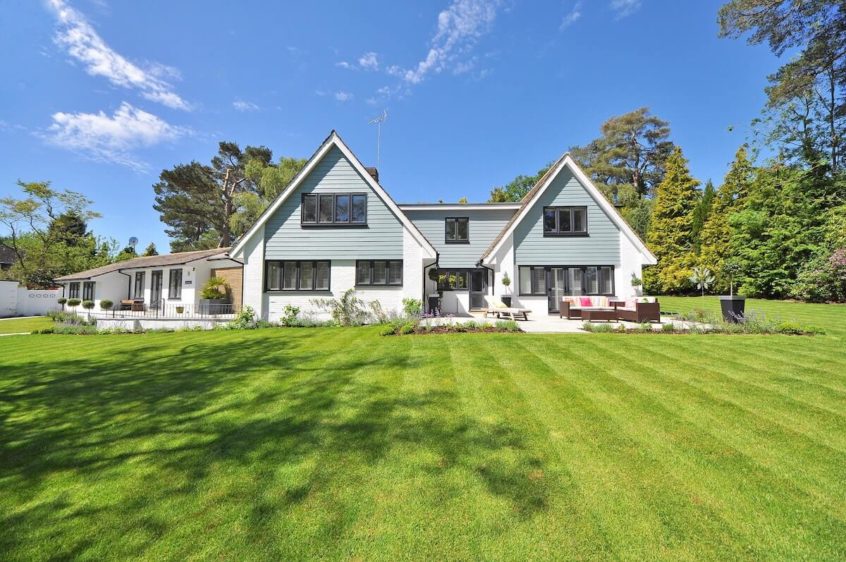The end of the summer is nearly here, but the temperatures haven’t come down yet. You (and your lawn) are probably feeling the heat right about now! If you have a cool-season turf, such as Kentucky Bluegrass, you may be able to see the signs of heat stress taking a toll on your yard.
No need to panic! Cool season lawns can absolutely make it through a heat wave no worse for wear. All you need is a little TLC and a lot of water. Check out our guide below on how to care for your cool season lawn in the summer heat.
Watering is Vital
Cool season lawns have it rough in the summertime. Any weather over 85 degrees can begin to cause heat stress. Prolonged temperatures of 90 and above can spell real problems for the appearance of your lawn. It’s important to know that cool-season turf grasses will go dormant during extreme heat spells. If your yard is looking a little crispy, it probably isn’t dead… unless you haven’t watered it.
The trick to helping a stressed or dormant lawn pass through extreme heat is to water, water, water. Then water again for good measure! We recommend giving your lawn 1/2 an inch to 3/4 an inch of water every two to three days. Water in the morning or the early afternoons if you can. Watering overnight can lead to lawn fungus. Heat dormancy is a defense mechanism for your lawn. So long as you keep on watering your lawn, it should flourish again once the worst of the heat wave has passed.
Should You Fertilize Your Lawn During a Heat Wave?
If your lawn is heat dormant, don’t fertilize it. Dormant lawns can’t absorb fertilizer. Just imagine someone trying to feed you while you sleep…. Not very effective! If your lawn isn’t dormant and is still showing some green, you can give it a little help with fertilizer, but you still have to keep on top of watering your lawn, too!
REMEMBER! Fertilizer is a supplement to a regular watering schedule, not a replacement for it. Here are a few of the fertilizers we recommend using once the heat spell has started to taper off. Legacy Turf Farms is not sponsored by any of these product manufacturers — we give our recommendations based on the products we use here for growing our turf!
Ironite (Granular OR Liquid): You can get this product at almost any local big box store. Just like the name sounds, Ironite is a high iron supplement. It can help your lawn green up slowly and shouldn’t kickstart any unwanted growth spurts. Follow the application instructions provided with the product closely — you’ll always see the best results when you follow the recommended instructions from the manufacturer.
Hydretain (Granular OR Liquid):
This soil moisture manager can help get a stressed lawn through the worst of the hot weather. If you have watering restrictions where you live and can’t provide 1/2 an inch to 3/4 an inch very two to three days, Hydretain is a great option. This lawn supplement acts as a humectant, drawing in moisture. In turn, your grass, trees, and other foliage have access to this moisture for longer than they would in untreated soil. Again, follow the manufacturer instructions closely for both the granular and liquid formulas.
Milorganite (Granular):
Milorganite is a great option for Fall fertilizing. It works well for both warm and cool season grasses. The slow-release formulas of Milorganite can feed a lawn for up to 10 weeks, so you can apply now toward the end of the heat wave and again once we’re well into Fall!
Should You Switch to a Warm-Season Grass?
Tired of battling the Georgia heat with your Fescue or Kentucky Bluegrass lawn? You wouldn’t be the first person to become frustrated with the time and attention it takes to tend to a cool-season lawn. Switching to a warm-season grass such as Bermuda or Zoysia could save you time and money.
Bermuda grass and Zoysia grass provide up to 7 months of vibrant green color. You get to enjoy a green lawn for longer, since warm-season grasses actively grow from April to October here in the Southeast. Better yet, when Fescue becomes discouraged by the dog days of summer, Bermuda and Zoysia actually prefer warm temperatures. These warm-season turfs thrive in the heat, and ground temperatures from 70 degrees Fahrenheit to 80 and 90 degrees Fahrenheit is when Bermuda and Zoysia are actively throwing out new shutes, or “runners” as they are commonly referred to. You’ll also see new top growth, or leaf growth, when warm temperatures combine with sufficient water and fertilizer.
Another great reason to make the switch to a warm season grass: a different mowing schedule. When you sod your lawn with Bermuda or Zoysia, you’ll mow during the warm months only. During the fall, winter, and early spring, you will not mow the lawn. Warm season lawns are dormant during the cool months, so you get to kick back and relax.
Can warm-season grass still experience heat stress? Yes — but it does not happen as often. Because these grasses are acclimated to the heat, it takes a longer drought and heat spell to send them into stress. Take a look at next month’s blog post to learn about heat stress in warm-season grasses.
